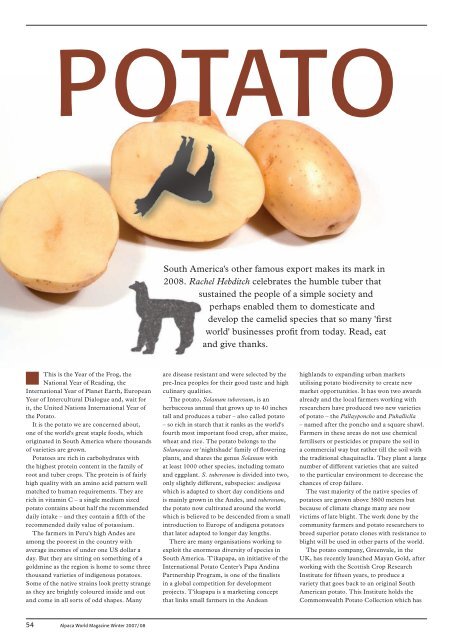Winter - Classical MileEnd Alpacas
Winter - Classical MileEnd Alpacas
Winter - Classical MileEnd Alpacas
You also want an ePaper? Increase the reach of your titles
YUMPU automatically turns print PDFs into web optimized ePapers that Google loves.
South America's other famous export makes its mark in<br />
2008. Rachel Hebditch celebrates the humble tuber that<br />
sustained the people of a simple society and<br />
perhaps enabled them to domesticate and<br />
develop the camelid species that so many 'first<br />
world' businesses profit from today. Read, eat<br />
and give thanks.<br />
This is the Year of the Frog, the<br />
National Year of Reading, the<br />
International Year of Planet Earth, European<br />
Year of Intercultural Dialogue and, wait for<br />
it, the United Nations International Year of<br />
the Potato.<br />
It is the potato we are concerned about,<br />
one of the world's great staple foods, which<br />
originated in South America where thousands<br />
of varieties are grown.<br />
Potatoes are rich in carbohydrates with<br />
the highest protein content in the family of<br />
root and tuber crops. The protein is of fairly<br />
high quality with an amino acid pattern well<br />
matched to human requirements. They are<br />
rich in vitamin C – a single medium sized<br />
potato contains about half the recommended<br />
daily intake – and they contain a fifth of the<br />
recommended daily value of potassium.<br />
The farmers in Peru's high Andes are<br />
among the poorest in the country with<br />
average incomes of under one US dollar a<br />
day. But they are sitting on something of a<br />
goldmine as the region is home to some three<br />
thousand varieties of indigenous potatoes.<br />
Some of the native strains look pretty strange<br />
as they are brightly coloured inside and out<br />
and come in all sorts of odd shapes. Many<br />
are disease resistant and were selected by the<br />
pre-Inca peoples for their good taste and high<br />
culinary qualities.<br />
The potato, Solanum tuberosum, is an<br />
herbaceous annual that grows up to 40 inches<br />
tall and produces a tuber – also called potato<br />
– so rich in starch that it ranks as the world's<br />
fourth most important food crop, after maize,<br />
wheat and rice. The potato belongs to the<br />
Solanaceae or 'nightshade' family of flowering<br />
plants, and shares the genus Solanum with<br />
at least 1000 other species, including tomato<br />
and eggplant. S. tuberosum is divided into two,<br />
only slightly different, subspecies: andigena<br />
which is adapted to short day conditions and<br />
is mainly grown in the Andes, and tuberosum,<br />
the potato now cultivated around the world<br />
which is believed to be descended from a small<br />
introduction to Europe of andigena potatoes<br />
that later adapted to longer day lengths.<br />
There are many organisations working to<br />
exploit the enormous diversity of species in<br />
South America. T'ikapapa, an initiative of the<br />
International Potato Center's Papa Andina<br />
Partnership Program, is one of the finalists<br />
in a global competition for development<br />
projects. T'ikapapa is a marketing concept<br />
that links small farmers in the Andean<br />
highlands to expanding urban markets<br />
utilising potato biodiversity to create new<br />
market opportunities. It has won two awards<br />
already and the local farmers working with<br />
researchers have produced two new varieties<br />
of potato – the Pallayponcho and Pukalliclla<br />
– named after the poncho and a square shawl.<br />
Farmers in these areas do not use chemical<br />
fertilisers or pesticides or prepare the soil in<br />
a commercial way but rather till the soil with<br />
the traditional chaquitaclla. They plant a large<br />
number of different varieties that are suited<br />
to the particular environment to decrease the<br />
chances of crop failure.<br />
The vast majority of the native species of<br />
potatoes are grown above 3800 meters but<br />
because of climate change many are now<br />
victims of late blight. The work done by the<br />
community farmers and potato researchers to<br />
breed superior potato clones with resistance to<br />
blight will be used in other parts of the world.<br />
The potato company, Greenvale, in the<br />
UK, has recently launched Mayan Gold, after<br />
working with the Scottish Crop Research<br />
Institute for fifteen years, to produce a<br />
variety that goes back to an original South<br />
American potato. This Institute holds the<br />
Commonwealth Potato Collection which has<br />
54 Alpaca World Magazine <strong>Winter</strong> 2007 / 08







